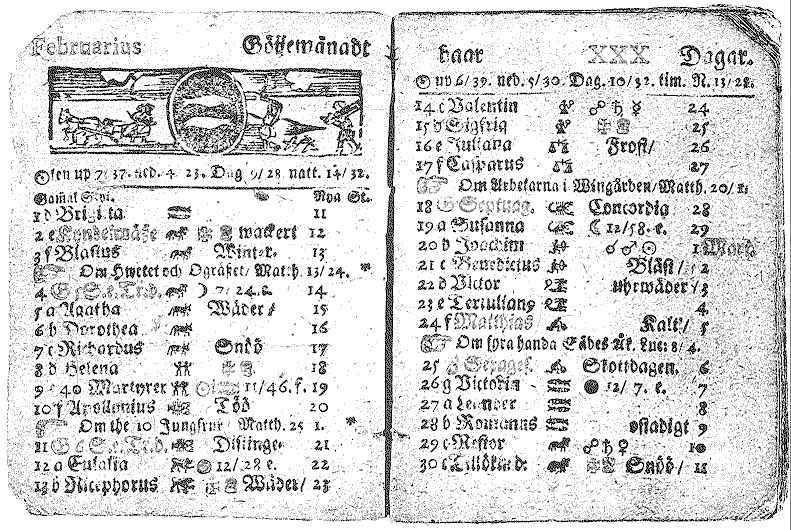
Even more complex as in the German Staes was the observance of Easter in Sweden (that until 1809 also included present-day Finland) from 1700 to 1844. Initially, the plan was to slowly migrate the calendar from the Julian style to the Gregorian style by leaving out each leap day correction from 1700 until 1740 while retaining the Dionysian Easter reckoning until 1740 after which the “improved” (astronomical) Easter reckoning would be observed.
Although the leap day of 1700 was correctly omitted, the subsequent leap days for 1704 and 1708 were inserted by mistake by the Swedish almanac makers, thus bringing the Swedish calendar one day out of step with the Julian calendar and 10 days out of step with the Gregorian calendar. In order to end this calendar confusion, it was decided in 1712 to revert back to the original Julian calendar by adding an extra leap day (February 30), thus creating a unique month that had never happened before and has not occurred since.

From 1712 to 1739 both the Julian calendar as the Dionysian Easter reckoning were observed in Sweden but in 1740 (as had been planned long before) the “improved” Easter reckoning was introduced though the Julian calendar was still retained. This caused the Swedish dates of Easter Sunday in 1742, 1744 and 1750 to wander outside of the traditional Easter limits (March 22 to April 25).
In 1753, one year after Great Britain and the British colonies adopted the Gregorian calendar and Easter reckoning, Sweden also adopted the Gregorian calendar but retained the “improved” Easter reckoning, even after it had been abandoned in 1776 by the protestant states of Germany. Thus Easter was observed a week later in Sweden than elsewhere in most of Europe on the astronomically calculated dates in 1802, 1805 and 1818. However, at the next two occurrences (in 1825 and 1829) Sweden appears to have followed the Gregorian reckoning but it was not until 1844, a year before the next anomalous Easter Sunday would occur, when Sweden formally adopted the Gregorian Easter reckoning, thus finally bringing its Easter reckoning in step with that of the Gregorian calendar.
| Year | Dionysian
Easter Sunday (Jul. cal.) |
Gregorian
Easter Sunday (Greg. cal.) |
Swedish Easter Sunday | Notes | |
| Swedish
calendar date |
Gregorian
calendar date |
||||
| 1700 | 31 March | 11 April | 1 April | 11 April | From 1700 to 1711 Dionysian
Easter reckoning reduced to the Swedish calendar (= Julian calendar + 1 day), except during the years 1705, 1709 and 1711 when Easter was observed one week earlier |
| 1701 | 20 April | 27 March | 21 April | 1 May | |
| 1702 | 5 April | 16 April | 6 April | 16 April | |
| 1703 | 28 March | 8 April | 29 March | 8 April | |
| 1704 | 16 April | 23 March | 17 April | 27 April | |
| 1705 | 8 April | 12 April | 2 April | 12 April | |
| 1706 | 24 March | 4 April | 25 March | 4 April | |
| 1707 | 13 April | 24 April | 14 April | 24 April | |
| 1708 | 4 April | 8 April | 5 April | 15 April | |
| 1709 | 24 April | 31 March | 18 April | 28 April | |
| 1710 | 9 April | 20 April | 10 April | 20 April | |
| 1711 | 1 April | 5 April | 26 March | 5 April | |
| From 1712 to 1739 Julian calendar with Dionysian Easter reckoning | |||||
| 1740 | 6 April | 17 April | 6 April | 17 April | From 1740 to 1752 Julian
calendar
with “improved” Easter reckoning |
| 1741 | 29 March | 2 April | 22 March | 2 April | |
| 1742 | 18 April | 25 March | 14 March | 25 March | |
| 1743 | 3 April | 14 April | 3 April | 14 April | |
| 1744 | 25 March | 5 April | 18 March | 29 March | |
| 1745 | 14 April | 18 April | 7 April | 18 April | |
| 1746 | 30 March | 10 April | 30 March | 10 April | |
| 1747 | 19 April | 2 April | 22 March | 2 April | |
| 1748 | 10 April | 14 April | 3 April | 14 April | |
| 1749 | 26 March | 6 April | 26 March | 6 April | |
| 1750 | 15 April | 29 March | 18 March | 29 March | |
| 1751 | 7 April | 11 April | 31 March | 11 April | |
| 1752 | 29 March | 2 April | 22 March | 2 April | |
| From 1753 to 1844 Gregorian calendar with “improved” Easter reckoning | |||||
| 1802 | – | 18 April | 25 April | 18 April | Years with anomalous
Easter dates
observed in this period |
| 1805 | – | 14 April | 21 April | 14 April | |
| 1818 | – | 22 March | 29 March | 22 March | |
Note: In Finland, that had been ceded by Sweden to Russia in 1809, the “improved” Easter reckoning remained in use until just before 1867 when the astronomical Easter Sunday was calculated to fall on 21 April and to coincide with the second day of Passover. Rather than to postpone Easter to 28 April it was decided to abandon the astronomical reckoning of Easter with the Passover postponement and to simply adopt the Gregorian reckoning.